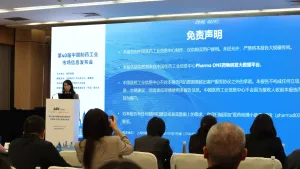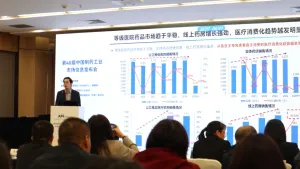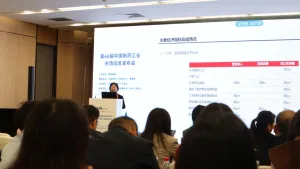
Beyond borders: Deloitte's Kavita Rekhraj explores trends, tech, and collaborations shaping healthcare in SEA
Her perspectives underscore the importance of agile, technology-driven approaches and cross-sector collaborations to address the dynamic healthcare needs of the region.
In light of the ever-evolving healthcare landscape, marked by technological advancements, demographic shifts, and changing consumer behaviours, it is imperative to glean insights from leaders at the forefront of this transformation.
One such industry expert is Kavita Rekhraj, Life Sciences & Health Care Leader at Deloitte Asia Pacific and Southeast Asia. With over two decades of experience in the consulting industry, Kavita brings a wealth of expertise in navigating the intricate nuances of the healthcare sector, particularly within the dynamic markets of Southeast Asia.
In her role, she spearheads initiatives aimed at activating new models of care, enhancing patient experiences, and driving digital transformations across the life sciences and healthcare domains. Her multidisciplinary background lies in customer engagement, market entry and access, route to market, channel management, and overall business and digital transformation.
As a judge for the Healthcare Asia Awards 2024, Kavita shared her insights and offered a comprehensive view of the opportunities and challenges that healthcare stakeholders are facing in the region.
Could you highlight some of the key trends you've observed in the region that are shaping the future of healthcare?
The healthcare landscape continues to evolve rapidly. Universal healthcare coverage is becoming more evident across the markets, including the more developed markets that are considering value-based care.
An ageing population – which will constitute about 13% of the population in Southeast Asia by 2030 and is expected to increase to more than 20% by 2050 – is driving the onset of chronic illnesses and further increasing the cost of care.
Rising healthcare-related out-of-pocket expenses pose a significant financial burden for consumers, which can lead to financial stress and limit access to the required level of care. For instance, in India, out-of-pocket expenditure accounted for 50% of total health spend in 2021. Government-sponsored health schemes constituted only 9.5% of healthcare spend, with only 54.1% of all individuals covered under the scheme.
Despite this, governments are laying the foundations to directly address these challenges related to access to affordable care. Some short-term developments include national programmes for digital health aiming to improve data quality via electronic medical records, healthcare interoperability, and connected healthcare services such as telemedicine and remote care.
Another key trend is the shift in mindset towards healthy living and wellness. This is particularly evident amongst the younger generation, who are now opting for healthier foods, engaging in exercise, and have a greater desire to take charge and bring positive change to their lifestyles. We have also observed an uptake in the adoption of wearables and other monitoring apps and devices and a greater openness to sharing personal data in exchange for better insights and recommendations, leveraging artificial intelligence (AI) and analytics.
Could you share some insights into the challenges and opportunities for healthcare companies in Southeast Asia as they seek to enhance access to healthcare services and improve health outcomes for underserved populations?
The healthcare sector in Southeast Asia has its share of structural challenges. Access to quality healthcare services varies widely across the region due to socio-economic and geographic factors. Many of the ASEAN countries have bed-to-patient and healthcare worker-to-patient ratios that fall below the Organisation for Economic Co-operation and Development (OECD) levels. In several countries, healthcare resources are unevenly distributed across the population, with the broadest supply-demand gaps in the least affluent and rural provinces.
Urban clustering of healthcare services also presents a notable issue in Southeast Asia. This leads to limited access to quality healthcare services in rural areas. For instance, Thailand has an over-allocation of resources in urban hospitals, leaving rural hospitals relatively under-resourced. The private healthcare system in Thailand also favours high-technology and high-cost specialist healthcare facilities to treat patients with complex conditions. The low penetration of insurance coverage also renders treatment options inaccessible for a sizable portion of the population.
Nevertheless, with a population base of over 700 million, Southeast Asia is an attractive destination for healthcare services. Whilst the scaling up of brick-and-mortar facilities is expected to continue, this will take time and is highly costly. Some feasible and more immediate options to address the access and quality gap in healthcare include alternative care models and strengthening the primary care infrastructure present.
There is also a growing use of digital health, which helps tackle the unmet needs of the underserved population. Digital health, which harnesses the newer technologies of AI and analytics, is being used in diagnostics and early detection of diseases, providing options for effective treatment and management when coupled with remote care services.
Additionally, access to a younger talent pool that is generally more receptive to technology adoption presents an opportunity to modernise health services and drive the adoption of technological innovations to lower the cost curve and promote public-private collaboration, particularly in the domains of telemedicine and primary care.
How do you see the adoption of digital technologies impacting patient experience and care delivery, particularly in diverse markets across Asia?
Digital health has the potential to significantly improve healthcare quality and access, primarily in three areas: patient and frontline worker experience; fundamental medical functions; and transforming information infrastructure.
Adoption will be influenced by a number of factors. This includes ease of use, particularly for the elderly and the differently abled who may be challenged by technology; government policies aimed at mainstreaming the use of digital technology; and national policies facilitating the digital transformation of healthcare through the use of initiatives around cloud adoption, data classification, health information exchanges, and unified healthcare mandates.
Additionally, digital front-door services, health information exchanges, and national-level disease surveillance and management systems are some examples of the many initiatives that fall under the umbrella of digital health. Collectively, they represent a massive opportunity to improve access to care at low-cost points and deliver significantly better outcomes whilst raising the overall situational awareness and preparedness to tackle national-level healthcare emergencies.
The proliferation of digital technologies will extend the reach of hospitals beyond their traditional walls. That being said, ensuring data privacy and data confidentiality will be critical to technology adoption. We must also bear in mind the strong element of trust between a patient and their primary care provider. This cannot be replaced by digitalisation. Therefore, it will be key to find a balance for incorporating digital means, including telemedicine, as part of the entire patient journey.
Given your expertise in market entry and access, what strategies do you recommend for companies looking to navigate regulatory landscapes and establish a foothold in new healthcare markets within the Asia-Pacific region?
The Asia-Pacific region has great diversity with respect to policy, regulation, and care delivery models, and healthcare organisations need to adopt a strategic and nuanced approach.
Deep market and regulatory knowledge will guide the development of tailored marketing strategies and product adaptations that resonate with local consumer preferences, whether targeting urban or rural populations.
An in-depth understanding of local regulatory frameworks and health policies, both traditional and digital, is key, given the focused investments in digital health innovations, telemedicine, AI diagnostics, and mobile health applications.
Companies can actively engage with governments and regulatory bodies to align business strategies with national healthcare priorities, which can smoothen market entry and contribute to shaping a more favourable regulatory environment.
In particular, strategic partnerships with broader ecosystem players and local entities are critical to gaining local market insights and navigating complex regulatory environments. These partnerships, especially in digital health initiatives, can leverage local expertise and distribution networks, enhancing access to healthcare services and products.
A core strategy companies should adopt is having a service differentiation and product/service-market fit, whilst also developing products and services tailored to the prevalent diseases and conditions in each market.
Finally, embracing digital transformation by investing in technologies that enable remote care, sophisticated data analytics, and enhanced patient engagement will help companies establish themselves in these markets.
As the healthcare landscape becomes increasingly globalised, what are some strategies for fostering cross-border collaborations and partnerships to drive innovation and address common healthcare challenges in the Asia-Pacific region?
Building international collaborations between the public and private sectors is essential for driving meaningful change. Engaging with global development organisations enables consensus-building, funding access, and joint tackling of healthcare challenges. Through collaborative research and knowledge exchange, stakeholders can pool resources and expertise and foster innovative solutions. This enhances research capabilities and encourages interdisciplinary cooperation, which leads to knowledge sharing and can inform global healthcare policies and practices.
Public-private partnerships will be crucial in promoting healthcare equity and innovation. In Asia-Pacific, there is evidence of such collaborations leading to initiatives focusing on healthcare interoperability, leveraging both sectors' strengths to address specific regional health challenges and improve access to quality care.
A collaborative framework for digital health policies and interoperability can streamline stakeholder cooperation, facilitating the adoption of standards and regulations. This improves treatment efficiency and continuity by ensuring interoperable systems and standards for efficient data exchange across healthcare platforms.
In your role as a judge at the Healthcare Asia Awards 2024, what are some of the criteria you prioritised when evaluating entries, and what trends or innovations were you particularly excited to see showcased in this year's submissions?
We increasingly see healthcare organisations taking ownership and working with the broader ecosystem to drive innovation and address patient centricity, quality care, scalability, and repeatability.
As such, I prioritised entries that showcase keeping patients at the centre, having an openness to work across ecosystems, and leveraging analytics, digitalisation and technology to develop high-impact and targeted patient outcomes.
I was excited to see the use of AI and analytics to drive better diagnostics and preventative care, telemedicine, and remote monitoring for broader care access. In addition, the use of digital therapeutics as software-based treatments, blockchain for secure medical record sharing, and interdisciplinary collaborations for well-rounded solutions make for exciting developments towards making quality healthcare accessible and affordable to the wider population.



















 Advertise
Advertise








